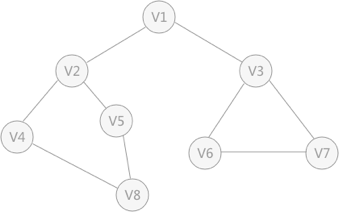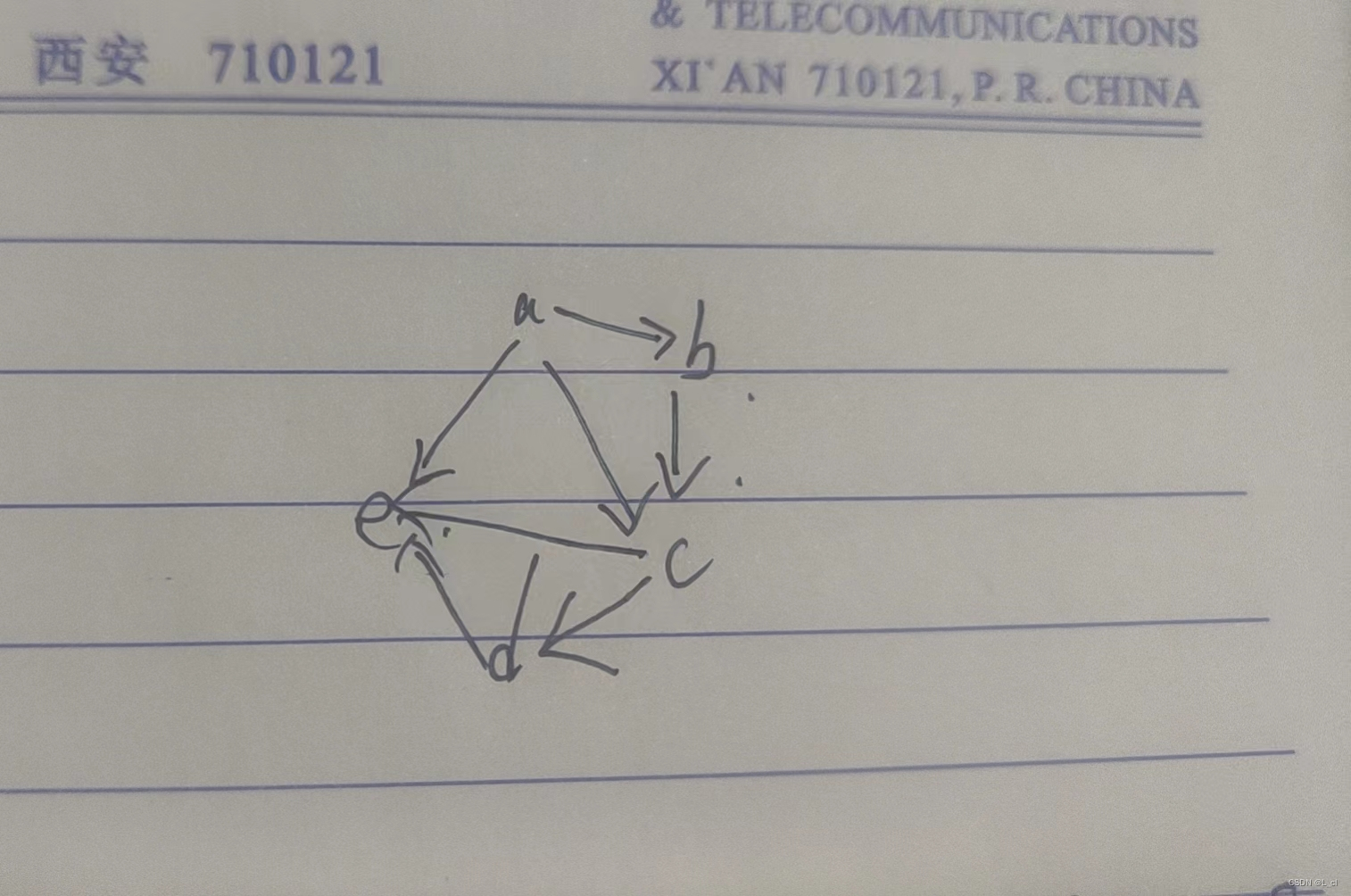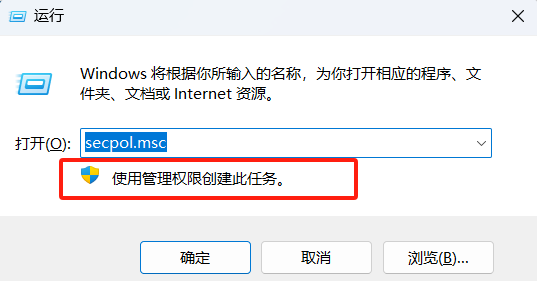广度优先搜索(Breadth-First Search,简称BFS)是一种用于遍历或搜索树或图数据结构的算法。其主要特性是以层级顺序遍历图的所有节点,从一个指定的起点开始,首先访问所有直接相连的邻居节点,然后再访问它们的邻居,以此类推,直至遍历完所有的可达节点。
BFS的工作原理:
选择起点:BFS从一个指定的起点开始。
初始化队列:创建一个空队列,并将起点插入队列中。
标记节点:起点被标记为“已访问”,以避免重复访问。
遍历队列:从队列中取出第一个节点,并访问它所有未被访问过的邻居节点。将这些邻居节点标记为“已访问”并插入队列的末尾。
重复过程:继续从队列中取出下一个节点,重复步骤4,直到队列为空。
终止条件:当队列为空时,算法结束,此时所有可达的节点都被遍历过了。
时间复杂度:
BFS的时间复杂度通常是O(V + E),其中V是图中的顶点数,E是边的数量。这是因为每个顶点和每条边都会被访问一次。
空间复杂度:
BFS的空间复杂度取决于队列的最大大小,最坏情况下,如果所有的节点都在队列中,则空间复杂度为O(V)。
应用场景:
- 最短路径:在无权图或权重相等的图中寻找两个节点之间的最短路径。
- 连通性:确定图是否连通,以及找出连通分量。
- 层次遍历:在树形结构中,按层次顺序访问节点。
- 拓扑排序:在有向无环图中进行排序。
- 迷宫求解:寻找从起点到终点的路径。
- 社交网络分析:例如计算用户之间的距离或找到共同朋友。
实现示例:
下面是一个使用Python实现的BFS算法示例,用于在图中寻找两个顶点之间的路径:
from collections import deque
def bfs(graph, start, goal):
# 创建一个队列并插入起点
queue = deque([start])
# 创建一个字典来存储每个节点的父节点
parents = {start: None}
while queue:
current = queue.popleft()
if current == goal:
# 目标节点已找到,构建并返回路径
path = []
while current is not None:
path.append(current)
current = parents[current]
return list(reversed(path))
# 遍历当前节点的所有邻居
for neighbor in graph[current]:
if neighbor not in parents:
# 标记邻居节点,并将其父节点设为当前节点
parents[neighbor] = current
queue.append(neighbor)
# 如果没有找到目标节点
return None
在上述示例中,graph是一个邻接列表,表示图的结构,start和goal分别表示起点和终点。该函数返回从start到goal的路径,如果没有找到路径则返回None。
广度优先搜索(Breadth-First Search,简称BFS)是一种用于遍历或搜索树或图数据结构的算法。在游戏开发中,BFS经常用来解决诸如寻路、迷宫求解、计算连通性、寻找最近的敌人或资源点等问题。
下面我将以一个典型的迷宫游戏作为案例,来详细讲解如何在Java中实现广度优先搜索。
游戏案例:迷宫寻路
假设我们有一个二维迷宫,由一系列的格子组成,每个格子可以是墙或者空地。玩家需要从起点找到到达终点的最短路径。我们可以使用BFS来解决这个问题。
1. 定义迷宫
首先,我们需要定义迷宫的结构。我们可以用一个二维数组来表示迷宫,其中0代表可通行的空地,1代表墙。
int[][] maze = {
{1, 1, 1, 1, 1, 1, 1},
{1, 0, 0, 0, 0, 0, 1},
{1, 0, 1, 1, 1, 0, 1},
{1, 0, 0, 0, 0, 0, 1},
{1, 1, 1, 1, 1, 1, 1}
};
2. 定义节点类
为了存储迷宫中的每个位置状态,我们需要创建一个节点类,包含位置坐标和从起点到该位置的距离。
class Node {
int x;
int y;
int distance;
Node(int x, int y, int distance) {
this.x = x;
this.y = y;
this.distance = distance;
}
}
3. 实现BFS
接下来,我们实现BFS算法。我们将使用队列来存储待访问的节点,并且维护一个布尔型的二维数组来标记已经访问过的节点。
public static boolean bfs(int[][] maze, int startX, int startY, int endX, int endY) {
// 队列用于存储待访问的节点
Queue<Node> queue = new LinkedList<>();
// 标记哪些节点已经被访问过
boolean[][] visited = new boolean[maze.length][maze[0].length];
// 将起点加入队列并标记为已访问
queue.add(new Node(startX, startY, 0));
visited[startX][startY] = true;
// 方向数组,用于四个方向的移动
int[][] directions = {{-1, 0}, {1, 0}, {0, -1}, {0, 1}};
while (!queue.isEmpty()) {
Node current = queue.poll();
// 如果找到了终点,返回true
if (current.x == endX && current.y == endY) {
System.out.println("Shortest distance: " + current.distance);
return true;
}
// 检查四个方向
for (int[] dir : directions) {
int newX = current.x + dir[0];
int newY = current.y + dir[1];
// 检查新位置是否在迷宫内并且未被访问过
if (newX >= 0 && newX < maze.length && newY >= 0 && newY < maze[0].length &&
maze[newX][newY] == 0 && !visited[newX][newY]) {
// 将新位置加入队列并标记为已访问
queue.add(new Node(newX, newY, current.distance + 1));
visited[newX][newY] = true;
}
}
}
// 如果没有找到路径,返回false
return false;
}
4. 调用BFS
最后,我们可以在主函数中调用bfs方法,传入迷宫和起点、终点的坐标。
public static void main(String[] args) {
int[][] maze = {
// 迷宫数组
};
boolean found = bfs(maze, 1, 1, maze.length - 2, maze[0].length - 2);
if (!found) {
System.out.println("No path found.");
}
}
这个算法可以确保找到从起点到终点的最短路径,如果存在多条最短路径,它会返回其中任意一条。
让我们将上述概念转化为一个完整的Java程序。我们将添加一些额外的功能,比如输出路径,以及处理没有找到路径的情况。以下是一个完整的示例代码:
import java.util.LinkedList;
import java.util.Queue;
public class MazeSolver {
private static final int WALL = 1;
private static final int PATH = 0;
public static void main(String[] args) {
int[][] maze = {
{1, 1, 1, 1, 1, 1, 1},
{1, 0, 0, 0, 0, 0, 1},
{1, 0, 1, 1, 1, 0, 1},
{1, 0, 0, 0, 0, 0, 1},
{1, 1, 1, 1, 1, 1, 1}
};
int startX = 1, startY = 1;
int endX = maze.length - 2, endY = maze[0].length - 2;
if (bfs(maze, startX, startY, endX, endY)) {
printPath(maze, startX, startY, endX, endY);
} else {
System.out.println("No path found.");
}
}
public static boolean bfs(int[][] maze, int startX, int startY, int endX, int endY) {
Queue<Node> queue = new LinkedList<>();
boolean[][] visited = new boolean[maze.length][maze[0].length];
queue.add(new Node(startX, startY, 0));
visited[startX][startY] = true;
int[][] directions = {{-1, 0}, {1, 0}, {0, -1}, {0, 1}};
while (!queue.isEmpty()) {
Node current = queue.poll();
if (current.x == endX && current.y == endY) {
setPath(maze, current);
return true;
}
for (int[] dir : directions) {
int newX = current.x + dir[0];
int newY = current.y + dir[1];
if (isValidMove(maze, newX, newY, visited)) {
queue.add(new Node(newX, newY, current.distance + 1));
visited[newX][newY] = true;
// Store the previous node to reconstruct the path later
maze[newX][newY] = current.distance + 1;
}
}
}
return false;
}
public static boolean isValidMove(int[][] maze, int x, int y, boolean[][] visited) {
return x >= 0 && x < maze.length && y >= 0 && y < maze[0].length &&
maze[x][y] == PATH && !visited[x][y];
}
public static void setPath(int[][] maze, Node endNode) {
int x = endNode.x;
int y = endNode.y;
while (maze[x][y] != 0) {
maze[x][y] = 2; // Mark the path with 2
int prevDist = maze[x][y] - 1;
for (int i = -1; i <= 1; i++) {
for (int j = -1; j <= 1; j++) {
if (i == 0 || j == 0) {
int newX = x + i;
int newY = y + j;
if (newX >= 0 && newX < maze.length && newY >= 0 && newY < maze[0].length &&
maze[newX][newY] == prevDist) {
x = newX;
y = newY;
break;
}
}
}
}
}
}
public static void printPath(int[][] maze, int startX, int startY, int endX, int endY) {
System.out.println("Path from (" + startX + ", " + startY + ") to (" + endX + ", " + endY + "):");
for (int[] row : maze) {
for (int cell : row) {
switch (cell) {
case WALL:
System.out.print("# ");
break;
case PATH:
System.out.print(". ");
break;
case 2:
System.out.print("* ");
break;
default:
System.out.print("S ");
}
}
System.out.println();
}
}
static class Node {
int x;
int y;
int distance;
Node(int x, int y, int distance) {
this.x = x;
this.y = y;
this.distance = distance;
}
}
}
在这个版本中,我们增加了以下功能:
setPath方法用于在找到路径后,通过回溯从终点到起点的节点距离来标记出整个路径。printPath方法用于打印迷宫,包括起点、终点和找到的路径。isValidMove方法用于检查下一步移动是否有效,即不超出迷宫边界、不是墙壁、且尚未访问过。
这样,我们不仅能够找出从起点到终点的最短路径,还可以在迷宫中可视化这条路径。
为了进一步完善代码,我们可以做以下几点改进:
- 错误处理:增加对输入参数的检查,确保迷宫和起始/结束点的有效性。
- 性能优化:在
bfs中,我们使用距离来追踪路径,这在小规模迷宫中可行,但在大规模迷宫中可能占用大量内存。我们可以改用前驱节点的方式,这样只需存储每个节点的前一个节点即可。 - 代码清晰性:分离关注点,比如将路径设置逻辑独立出来。
下面是根据这些改进后的代码:
import java.util.LinkedList;
import java.util.Queue;
public class MazeSolver {
private static final int WALL = 1;
private static final int PATH = 0;
private static final int START = 3;
private static final int PATH_MARK = 2;
public static void main(String[] args) {
int[][] maze = {
{1, 1, 1, 1, 1, 1, 1},
{1, 0, 0, 0, 0, 0, 1},
{1, 0, 1, 1, 1, 0, 1},
{1, 0, 0, 0, 0, 0, 1},
{1, 1, 1, 1, 1, 1, 1}
};
int startX = 1, startY = 1;
int endX = maze.length - 2, endY = maze[0].length - 2;
if (validateMaze(maze, startX, startY, endX, endY)) {
if (bfs(maze, startX, startY, endX, endY)) {
printPath(maze, startX, startY, endX, endY);
} else {
System.out.println("No path found.");
}
} else {
System.out.println("Invalid maze or start/end points.");
}
}
private static boolean validateMaze(int[][] maze, int startX, int startY, int endX, int endY) {
return startX >= 0 && startY >= 0 && endX >= 0 && endY >= 0 &&
startX < maze.length && startY < maze[0].length &&
endX < maze.length && endY < maze[0].length &&
maze[startX][startY] == PATH && maze[endX][endY] == PATH;
}
public static boolean bfs(int[][] maze, int startX, int startY, int endX, int endY) {
Queue<Node> queue = new LinkedList<>();
boolean[][] visited = new boolean[maze.length][maze[0].length];
int[][] predecessors = new int[maze.length][maze[0].length];
for (int[] row : predecessors) {
java.util.Arrays.fill(row, -1);
}
queue.add(new Node(startX, startY, null));
visited[startX][startY] = true;
int[][] directions = {{-1, 0}, {1, 0}, {0, -1}, {0, 1}};
while (!queue.isEmpty()) {
Node current = queue.poll();
if (current.x == endX && current.y == endY) {
setPath(predecessors, current);
return true;
}
for (int[] dir : directions) {
int newX = current.x + dir[0];
int newY = current.y + dir[1];
if (isValidMove(maze, newX, newY, visited)) {
queue.add(new Node(newX, newY, current));
visited[newX][newY] = true;
predecessors[newX][newY] = current.distance;
}
}
}
return false;
}
public static boolean isValidMove(int[][] maze, int x, int y, boolean[][] visited) {
return x >= 0 && x < maze.length && y >= 0 && y < maze[0].length &&
maze[x][y] == PATH && !visited[x][y];
}
public static void setPath(int[][] predecessors, Node endNode) {
int x = endNode.x;
int y = endNode.y;
while (predecessors[x][y] != -1) {
Node prev = predecessors[x][y];
maze[x][y] = PATH_MARK; // Mark the path with 2
x = prev.x;
y = prev.y;
}
maze[x][y] = START; // Mark the start point
}
public static void printPath(int[][] maze, int startX, int startY, int endX, int endY) {
System.out.println("Path from (" + startX + ", " + startY + ") to (" + endX + ", " + endY + "):");
for (int[] row : maze) {
for (int cell : row) {
switch (cell) {
case WALL:
System.out.print("# ");
break;
case PATH:
System.out.print(". ");
break;
case PATH_MARK:
System.out.print("* ");
break;
case START:
System.out.print("S ");
break;
default:
System.out.print(" ");
}
}
System.out.println();
}
}
static class Node {
int x;
int y;
Node distance;
Node(int x, int y, Node distance) {
this.x = x;
this.y = y;
this.distance = distance;
}
}
}
在这个版本中,我们进行了以下改进:
- 使用
predecessors数组来存储每个节点的前驱节点,而不是其距离。 - 在
setPath方法中,我们通过遍历predecessors数组来重构路径。 - 添加了
validateMaze方法来确保迷宫和起始/结束点的有效性。
这样,我们的代码现在更加健壮,更易于理解和维护。































